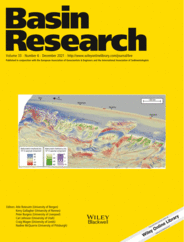
Full text loading...
 , Max C. Firkins1, Thuwaiba S. Al Wahaibi1, Estella A. Atekwana2
, Max C. Firkins1, Thuwaiba S. Al Wahaibi1, Estella A. Atekwana2 , Michael J. Soreghan1
, Michael J. Soreghan1
Although much is known about the interaction of faulting and sedimentation within the basins of active segmented continental rift systems, little is known about these processes within the interaction zones of varying geometries that separate the young interacting segments. We address this problem by exploring the non‐volcanic rift interaction zones (RIZ) along the humid, magma‐poor juvenile western branch of the East African Rift System (WB‐EARS). We examine the large‐scale ‘cross‐over’ relief profiles (basin‐to‐basin through‐going profiles extending across RIZs), the spatial patterns of rift‐linking faults (breaching faults), and axial stream morphology. Our results show that: (1) the RIZs are at different stages of their evolution; (2) distinct long‐wavelength 2‐D cross‐over topographic relief shapes, directionality of axial stream flow (sediment routing patterns), and breaching fault patterns characterise RIZs at the various stages of the linkage of interacting rift basins; (3) these stages include unbreached, partially‐breached, recently‐breached, and breached RIZs; (4) deforming RIZs exhibit different styles of directionality of breaching, including a unidirectional (distinct propagator and receiver segments), bi‐directional propagation (both segments act as propagators and receivers), and nucleation and outward propagation of a narrow intra‐RIZ subsidiary rift basin; (5) RIZ breaching is facilitated by overlap rift‐flank deformation, and/or rift tip propagation structures in the form of rift splaying, border fault rotation (rift‐tip rotation), and fault cluster networks and (6) the lateral propagation of breaching faults at the rift tips and flanks, facilitated by localized stress concentrations, is modulated by the extension direction and inherited basement structures. Our findings offer a broader insight into the geometries, structural, and morphological evolution of RIZs, and provide first‐order predictions of the large‐scale sedimentation patterns of humid early‐stage continental rift environments. Our models provide testable hypotheses for linking rift architecture and patterns of early stage sedimentation applicable to ancient rift basins.
,During the early stages of continental extension, isolated rift segments propagate laterally and interact to link‐up at RIZs. In this study, we investigate RIZs in East Africa to decipher the stages of their evolution and gain insights relevant for understanding the evolution of rift systems.

Article metrics loading...

Full text loading...
References


Data & Media loading...

